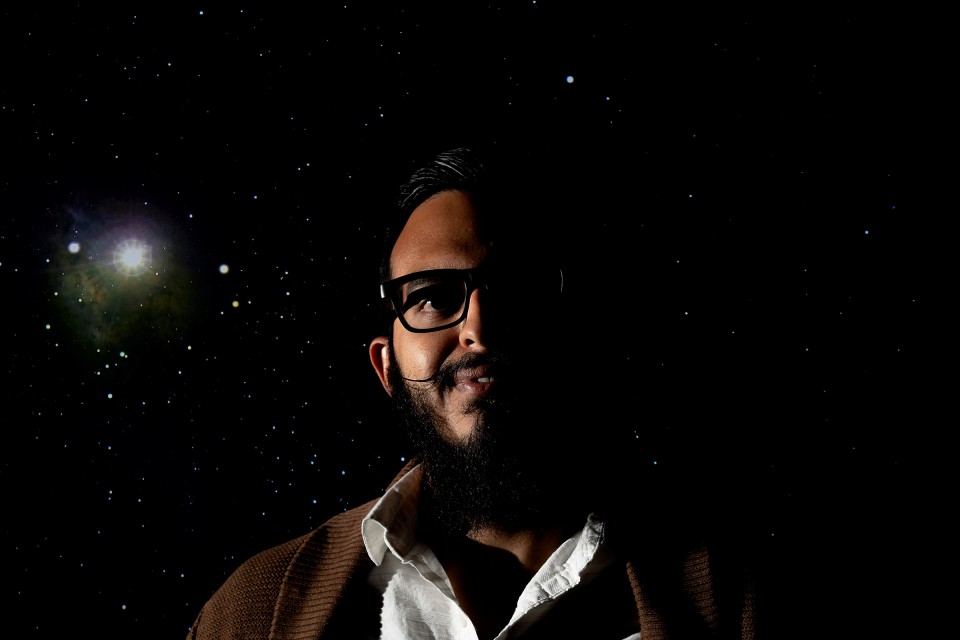A UTRGV researcher shares possible explanations of Biblical account. Moises Castillo, the assistant director for the UTRGV Dr. Cristina V. Torres Memorial Astronomical Observatory, talks about some astronomical possibilities for the Star of Bethlehem.
UTRGV researcher shares possible scientific explanations for Biblical account
Wednesday, December 18, 2019
Around Campus
By Maria Elena Hernandez
RIO GRANDE VALLEY, TEXAS – There are countless stars in the sky, but one, particularly, is tied to Christmas – the Star of Bethlehem. According to the Gospel of Matthew, a star led the magi to Jesus.
“It is possible to use stars for navigation,” said Moises Castillo, assistant director of the UTRGV Dr. Cristina V. Torres Memorial Astronomical Observatory at Resaca de la Palma State Park in Brownsville.
“However, multiple sources recording the same event happening is typically how we function as astronomers,” he said. And in the case of the Star of Bethlehem, it is only mentioned in a few Bible verses.
The magi, arriving in Jerusalem from the east, saw “His star at its rising.” Some versions of the Bible say, “His star in the east.” And, the star “went on before them until it came and stood over the place where the Child was.”
“In ancient cultures, astronomy and astrology were typically tied,” Castillo said, “they were unified. The positions of stars and planets were kept track of. There may actually have been a particular planetary alignment that meant that there would be the birth of a king.
"So, whenever there was this particular star alignment or planetary alignment, they would say, ‘Oh, we're in the era of the birth of a new king.’”
Unfortunately for scientific minds, he said, “There isn’t a clear documentation.”
ANCIENT ASTRONOMICAL EVENTS
Still, some records about astronomical events at the time do exist.
“A lot of astronomers who want to look at ancient astronomical events typically refer to Chinese recordings,” Castillo said.
Astronomical transient events – like any increase of light or a sudden change in what appear to be stars – would have been recorded.
“One of the things that did come up with was a ‘variable’ star, which repeatedly would become brighter. But apparently, it dated back to 4 or 5 B.C.,” Castillo said.
Still, that date might not eliminate it as a possibility for the Star of Bethlehem. Debate is ongoing about what year Jesus was born, and some researchers have placed his birth at between 6 B.C. and 4 B.C. Others suggest it was earlier, and some place it later than 2 A.D.
POSSIBILITIES IN THE SKY
“Stars are considered variable stars if the brightness or color observed changes with respect to time,” Castillo said. “The changes can be regular or irregular, with periods as quick as a few hours to a few months or even many years. The variability can come about due to internal physical processes, like pulsating, or external processes, like eclipsing binary stars.”
Researchers also have suggested that, if it existed, the Star of Bethlehem was a comet, a supernova or a triple conjunction.
“A triple conjunction is where there are two objects that meet up, whether it’s a star and a planet or two planets aligning,” Castillo said.
Those objects align three times in a short period – hence the triple conjunction – each time causing an increase in brightness.
“It’s a pretty rare event,” he said.

INDIRECT RECORDS
The Bible’s mention of the Star of Bethlehem wouldn’t be the only instance of an astronomical event found outside of astronomical records.
“A group of researchers found evidence using the Egyptian Cairo calendar for documentation of variable stars,” Castillo said. “It was embedded in text. It wasn’t something that was apparent. There wasn’t just, ‘This star has this certain magnitude and this certain position.’ So, there’s potential there,” Castillo said.
OTHER EXPLANATIONS
Outside of a poorly document astronomical event, Castillo offers two other possibilities for the Star of Bethlehem.
“There could have been some divine being,” he said. “Or there could have been something that was able to control that specific star using known physics.
“And another option would be that the entire story is just a story,” he said. “In that case, there would be no evidence for anything else.
“As a real event that happened? It’s pretty much up in the air.”
STARGAZING EVENTS
Whatever your personal take on the Star of Bethlehem, the UTRGV Dr. Cristina Torres Memorial Astronomical Observatory offers the opportunity to see the stars as they are now.
The observatory, located at the Resaca de la Palma State Park in Brownsville, is open to the public the last Friday of every month.
You can also stargaze with the UTRGV Physics Department staff at the Winter Solstice Celebration, Saturday, Dec. 21, at the observatory. The South Texas Astronomical Society will host the event, which begins at 5 p.m. and continues until 8:30 p.m. The celebration includes making crafts and learning about the science behind winter solstice.
Link to Facebook event page: https://www.facebook.com/events/3101741613172579/
ABOUT UTRGV
The University of Texas Rio Grande Valley (UTRGV) was created by the Texas Legislature in 2013 as the first major public university of the 21st century in Texas. This transformative initiative provided the opportunity to expand educational opportunities in the Rio Grande Valley, including a new School of Medicine and a School of Podiatry, and made it possible for residents of the region to benefit from the Permanent University Fund – a public endowment contributing support to the University of Texas System and other institutions.
UTRGV has campuses and off-campus research and teaching sites throughout the Rio Grande Valley including Brownsville (formerly The University of Texas at Brownsville campus), Edinburg (formerly The University of Texas-Pan American campus), Harlingen, Weslaco, McAllen, Port Isabel, Rio Grande City and South Padre Island. UTRGV, a comprehensive academic institution, enrolled its first class in the fall of 2015; the School of Medicine welcomed its first class in the summer of 2016, and the School of Podiatric Medicine in the fall of 2022.
